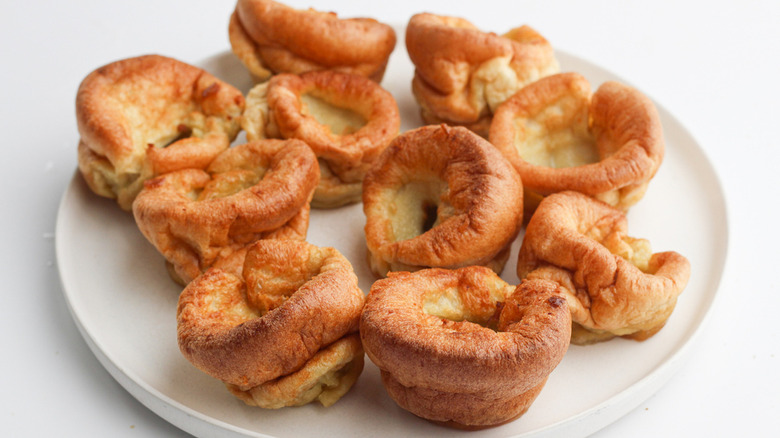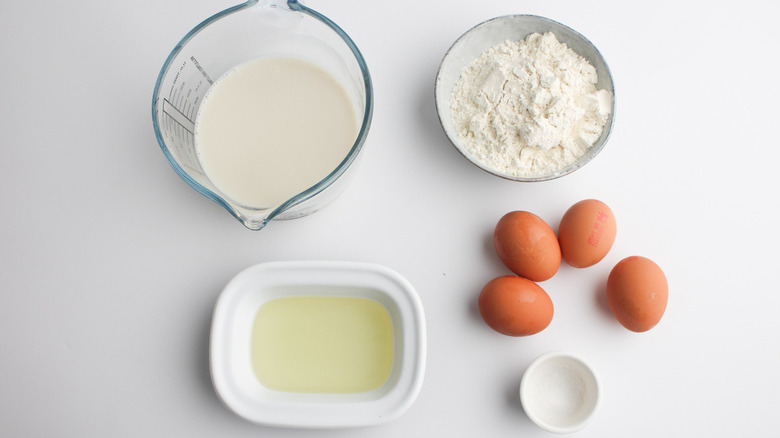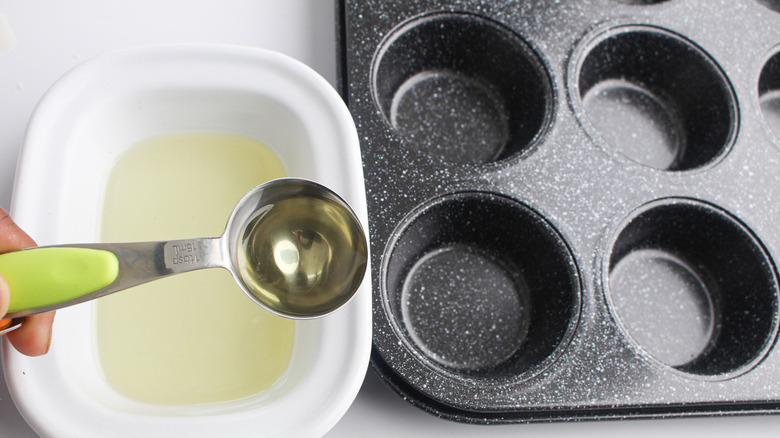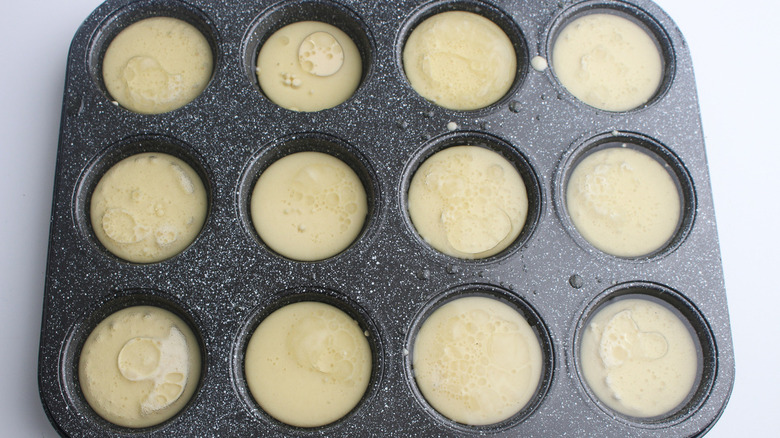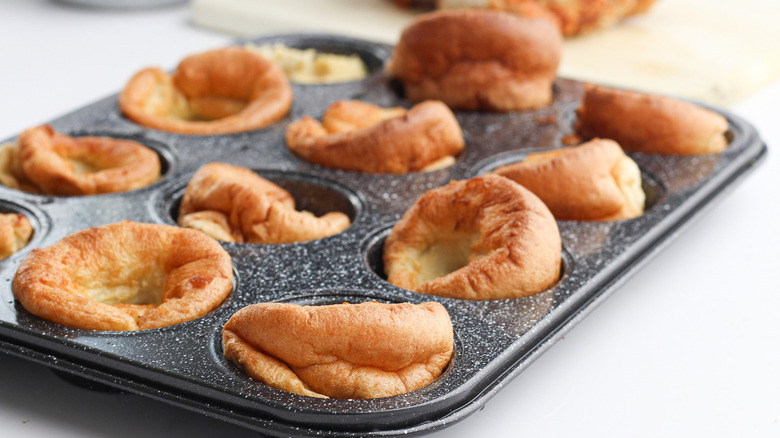Traditional Yorkshire Pudding Recipe
Yorkshire puddings are from, you guessed it, Yorkshire, England. And while there seems to be no official date on when this dish was first created, it goes back at least to the 1700s where a recipe for one first appeared in a cookbook, according to Historic UK. The word was first used in a recipe for a batter pudding that was relatively light compared to practically all of the other puddings at the time. Yes, crispy. While Americans might associate the word "pudding" with a rather thicky, creamy, sweet dessert, the British know it as a "batter pudding" that's not unlike a cake. Treats such as these are often served either before or during a meal.
There are many variations of Yorkshire pudding, with some even made extra savory with the addition of meat. Whether they are cooked with or without that protein, many are even served with gravy.
Our recipe is a traditional batter pudding. Recipe developer Susan Olayinka told Mashed that one of her favorite things about this traditional Yorkshire pudding recipe is its texture. According to her, this pudding is "crispy on the outside and soft on the inside." She added that Yorkshire puddings are her favorite part of roast dinners because simply put, they taste "amazing." So if you're planning a roast dinner soon, you should serve up some pudding as an extra treat.
Gather the ingredients for the traditional Yorkshire pudding
Because Yorkshire pudding dates back at least a few hundred years, you won't find any uncommon ingredients in most recipes, at least not if you're most familiar with European-style foods.
In fact, this recipe's ingredients list is surprisingly simple, to the point where you may already have most or all of the ingredients on hand at home. All told, you will only need five items for our traditional Yorkshire pudding recipe: olive oil, all-purpose flour, salt, eggs, and whole milk. Yes, that's really it. But remember that, with just a little bit of work and some careful cookery, you'll have a delicious Yorkshire pudding out of this assemblage in no time.
Preheat the oven and a 12-cup muffin tray
The first step is to preheat the oven to 425 F. Doing so now gives your oven a chance to get up to the proper heat needed to cook your Yorkshire puddings, so you won't have to sit around while it preheats at the end.
While you are waiting for the oven to heat up, you can work on preparing the muffin tray. To do this, simply place 2 tablespoons of olive oil in each cup. Then place the tray in the oven for 15 minutes. According to Olayinka, "the tray is heated to avoid soggy bottoms for the puddings." And, given how much many of us have learned to fear the soggy bottom thanks to Paul Hollywood's memorable criticisms on The Great British Baking Show, this is definitely not a step to skip.
Make the batter for Yorkshire pudding
While you are waiting for the muffin tray to get hot, you can easily start work on the batter. Put the all-purpose flour, salt, eggs, and milk in a medium-sized mixing bowl and stir until everything is thoroughly combined.
Olayinka says there is no special order or speed to mix the batter. You just make sure that everything is combined. Of course, once you've reached that point, you'll want to stop in order to avoid overmixing. If you don't, there's a chance you may end up with an overly tough final product.
Once everything's been mixed together, transfer the batter to a pourable container.
Fill the muffin cups
After the tray has been in the oven for 15 minutes, remove it from the oven. Use a pastry or basting brush to coat the sides of the muffin tray cups with the oil. This will help ensure that the puddings will release easily from the tray at the end of the process, as well as helping achieve those beautifully crisp sides. Good Housekeeping notes that the oil in the tray should be sizzling when you pour the batter into the cups.
When you pour the batter into each cup, leave about ½ inch of space at the top. This will give the puddings room to rise without overflowing their individual spaces in the tray.
Bake, serve, and enjoy
The next step is, as you've probably already guessed, waiting for the pudding to bake. After 22 minutes in the oven, your Yorkshire puddings should be ready. They will be golden brown and should have puffed up out of their cups during this process.
Remove the puddings from the muffin tray and serve them immediately. While Yorkshire pudding is generally served with gravy, there are dozens of ways it can be enjoyed. That could include different types of meats, sauces, or whatever your heart desires. For a bit of a healthy kick, you can also eat them loaded with vegetables, beans, or rice. Whatever path you choose, we're sure you'll be making this simple, classic recipe for Yorkshire pudding over and over!
Traditional Yorkshire pudding recipe
This recipe for an easy and traditional Yorkshire pudding is light, crisp, and perfect for savory additions like gravy, meat, vegetables, and much, much more.
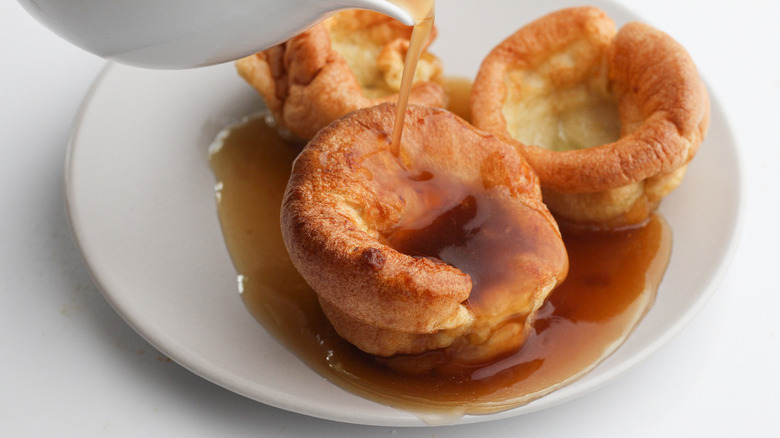
Ingredients
- 24 tablespoons olive oil
- 1 cup all-purpose flour
- ½ teaspoon salt
- 4 eggs
- 1½ cup whole milk
Optional Ingredients
- Gravy
Directions
- Preheat the oven to 425 F. Place 2 tablespoons of olive oil into each cup of the muffin tray. Place the baking tray in the oven for 15 minutes.
- In a mixing bowl, mix all-purpose flour, salt, eggs, whole milk until combined.
- Transfer the batter to a pourable container.
- After 15 minutes, take the muffin tray out. Immediately use a pastry or basting brush to brush oil onto the sides of the tray's cups.
- Pour the batter inside the cups. Leave ½ inch of space from the top of each cup.
- Bake for 22 minutes.
- Once done, serve immediately.
Nutrition
| Calories per Serving | 316 |
| Total Fat | 29.5 g |
| Saturated Fat | 4.8 g |
| Trans Fat | 0.0 g |
| Cholesterol | 56.4 mg |
| Total Carbohydrates | 9.5 g |
| Dietary Fiber | 0.3 g |
| Total Sugars | 1.6 g |
| Sodium | 131.1 mg |
| Protein | 3.8 g |
